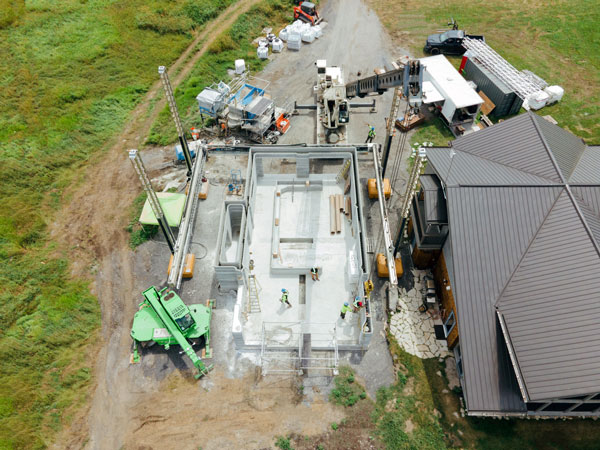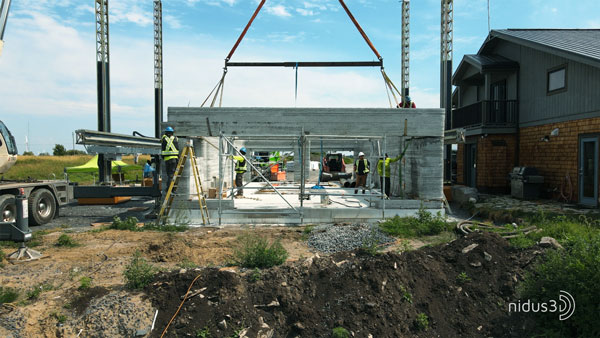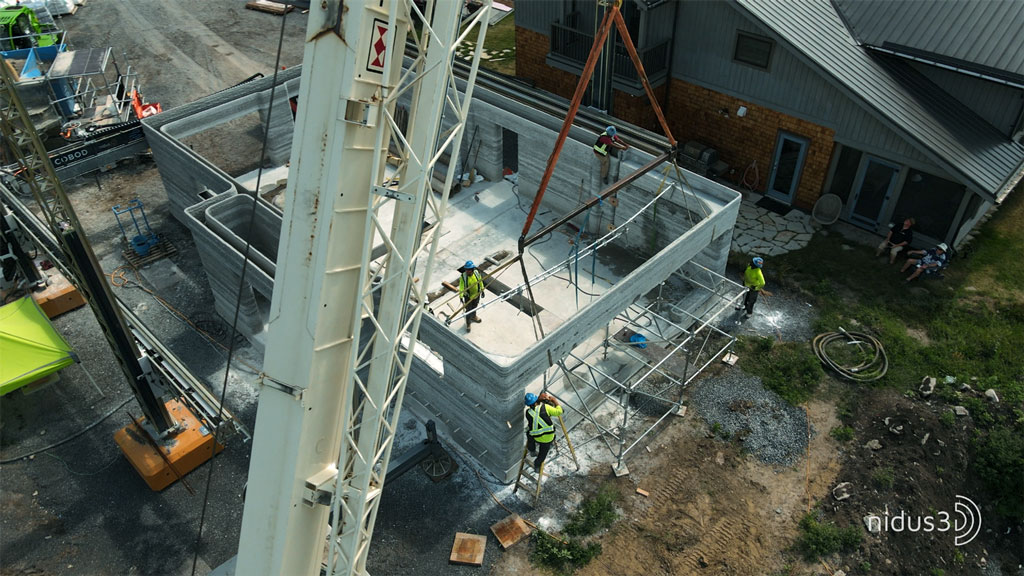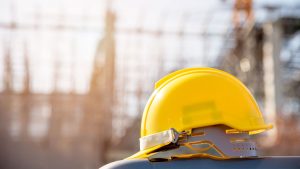The grey shell of the first-ever 3D-printed, multi-storey, mixed-use concrete building in North America has been completed on Wolfe Island near Kingston, Ont.
Mechanical and electrical trades along with roofers have now been called in to complete the rest of the structure.
The venue, being constructed by nidus3D, is a 2,300-square-foot, two-storey building that will feature a workshop on the ground floor and a residence above. The exterior took 80 hours to print.
“It’s significant because it’s printed in concrete instead of mortar which allows us to use pre-approved mix designs,” says Ian Arthur, one of the nidus3D founders. “Mortar mixes tend to change. They’re a little easier to print with, but there’s a lot more limitations associated with them.”
Because concrete was used, print crews were able to use locally sourced aggregate, unlike mortar which requires cement, fine sand and lime.
“One of the great things about using a concrete mix is we are able to vet and source local materials no matter where we land with the printer,” says Arthur. “Consistency is our biggest challenge, finding suppliers who really take the time with the grading and consistency of the aggregate.
“We anticipate that, as we grow and expand and deploy printers into other parts of Ontario and across Canada, we will continue to find local sources of all these materials, because one of the ways to be competitive is that we’re mixing concrete onsite and we’re sourcing everything locally which lowers everything from a green perspective but also your costs in terms of logistics and freight.”
Nidus3D used the BOD2 printer from COBOD, a Danish company that provides 3D construction printing solutions. The same technology was used to 3D-print the first two- and three-storey buildings in Europe. The BOD2 can use concrete with a particle size up to 10 millimetres.
COBOD developed the low-cost solution, called D.Fab, in co-operation with the cement giant Cemex.
A four-person print crew consisting of a printer operator and three generalists worked on the Kingston project.
“We’ve been able to do some really cool things,” says Arthur. “We did a poured concrete floor for soundproofing between the two storeys and we 3D-printed an additional mechanical room. The second storey is going to be an in-law suite for the main property, so it’ll be a small apartment.”
To date, all 3D-printed buildings in Canada and the U.S. have been single-storey. The Kingston structure will be completed by early December.
“We met with the trades last week to talk about what the final scopes of work are to pull together the rest of the building,” says Arthur.
The nidus3D team started with a concrete foundation. The printer was brought in and the walls were constructed. A steel truss roof is to be installed and is being done in partnership with another company.
“We print onsite. On that particular job, we arrived with the poured pad ready to go,” says Arthur. “The inside plumbing and everything had already been placed and we printed around it.”
Of particular interest, the 3D printer was used to build a horizontal concrete beam onsite that was lifted into place by a crane. An engineer worked out the specs and nidus3D used the printer to make a custom piece of formwork for the beam.
“We printed the formwork and reinforced it with rebar as per the schedule provided and grouted it with concrete,” says Arthur. “We were able to create a traditional concrete beam from a 3D-printed form.”
The beam would have been a difficult piece to ship to the site. The team was able to create it with some additional labour costs.
The form for the beam was printed in an open area on the first floor of the building and was then hoisted into place.
“It was a significant achievement and we were really proud of that,” says Arthur. “It went really well.”
While the 3D printing industry is still in its infancy, it is growing exponentially. Various reports indicate year-over-year growth to be 80 to 110 per cent. Nidus3D is already working on a 3D-printed basement for another project.
“There is progression every single day,” says Arthur. “We are right at the beginning of this but it’s already probably faster than most traditional ways of putting up masonry buildings. We anticipate it being faster than wood-frame construction in a very short time-frame and we anticipate the costs being lower. We anticipate by next year being able to build a storey a day of a house with this printer.”
According to Arthur, 3D printing will also help the industry deal with the growing demand for housing and offset some of the problems caused by the anticipated shortfall of skilled labour.
“If we do not begin to look at new ways of building, we’re never going to catch up. It is part of our core values to seek solutions to address the housing crisis and to help build affordable housing.”
“We met with the trades last week to talk about what the final scopes of work are to pull together the rest of the building,” says Arthur.

The nidus3D team started with a concrete foundation. The printer was brought in and the walls were constructed. A steel truss roof is to be installed and is being done in partnership with another company.
“We print onsite. On that particular job, we arrived with the poured pad ready to go,” says Arthur. “The inside plumbing and everything had already been placed and we printed around it.”
Of particular interest, the 3D printer was used to build a horizontal concrete beam onsite that was lifted into place by a crane. An engineer worked out the specs and nidus3D used the printer to make a custom piece of formwork for the beam.
“We printed the formwork and reinforced it with rebar as per the schedule provided and grouted it with concrete,” says Arthur. “We were able to create a traditional concrete beam from a 3D-printed form.”

The beam would have been a difficult piece to ship to the site. The team was able to create it with some additional labour costs.
The form for the beam was printed in an open area on the first floor of the building and was then hoisted into place.
“It was a significant achievement and we were really proud of that,” says Arthur. “It went really well.”
While the 3D printing industry is still in its infancy, it is growing exponentially. Various reports indicate year-over-year growth to be 80 to 110 per cent. Nidus3D is already working on a 3D-printed basement for another project.
“There is progression every single day,” says Arthur. “We are right at the beginning of this but it’s already probably faster than most traditional ways of putting up masonry buildings. We anticipate it being faster than wood-frame construction in a very short time-frame and we anticipate the costs being lower. We anticipate by next year being able to build a storey a day of a house with this printer.”
According to Arthur, 3D printing will also help the industry deal with the growing demand for housing and offset some of the problems caused by the anticipated shortfall of skilled labour.
“If we do not begin to look at new ways of building, we’re never going to catch up. It is part of our core values to seek solutions to address the housing crisis and to help build affordable housing.”











Very interesting .Please share more details .Thanks